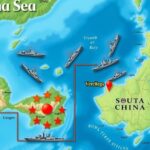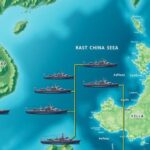Politics
AMERICA, ASIA, AUSTRALIA, CHINA, CUBA, DEFENSE, EASTERN THEATER COMMAND, GEOPOLITICS, HE, HEGSETH, JAPAN, KOREA, MEXICO, MILITARY, NEW ZEALAND, NORTH AMERICA, OCEANIA, PETE HEGSETH, PHILIPPINES, SC, SCS, SHI YI, SOUTH CHINA SEA, SOUTH CHINA SEA DISPUTE, TAIPEI, TAIWAN, TAIWAN STRAIT, TERRITORIAL DISPUTES, TOKYO, U. S, US-CHINA RELATIONS
Omar El-Sharif
China Conducts Major Military Exercises Around Taiwan Amid U.S.-Japan Defense Reinforcement
China has initiated expansive military drills near Taiwan, warning against its independence efforts, while the U.S. strengthens military collaboration with Japan to deter Chinese aggression. Taiwan condemns China’s military provocations, asserting its de-facto independence. Enhanced U.S.-Japan defense ties reflect concerns over regional stability amid increasing military activities by China.
The Chinese military has commenced significant military exercises around Taiwan, employing naval and air forces including an aircraft carrier battle group. These drills serve as a stern warning against Taiwan’s aspirations for formal independence. Shi Yi, spokesperson for the People’s Liberation Army’s Eastern Theater Command, stated the exercises are intended as a “severe warning against Taiwan independence.” China considers Taiwan as its territory and aims to assert its control, even by force if necessary.
Taiwan’s Presidential Office condemned China’s military provocations, highlighting the threat they pose not only to Taiwan but to regional security, citing drills that occur near nations such as Australia and Japan. Taiwan asserts that most of its populace supports its status quo of de-facto independence, conflicting with China’s territorial claims, which it reinforces through military drills in the area.
The commencement of these exercises coincides with a recent visit by U.S. Defense Secretary Pete Hegseth to Japan, where the U.S. announced enhanced military collaboration aimed at countering Chinese military aggressiveness. The partnership with Japan is deemed essential for regional stability, and multiple defense agreements were made, including advancements in missile development and joint operational command.
During these exercises, Taiwan’s defense ministry monitored 71 Chinese aircraft and 21 warships, indicating significant military movement surrounding the island, including activities of the Shandong aircraft carrier. Taiwanese Defense Minister Wellington Koo commented, stating that these actions disrupt regional peace and were mirrored by a central response group organized by Taiwan to address military threats.
Beijing responded to Taiwanese actions under President Lai Ching-te, who has faced criticism for promoting a pro-independence agenda, prompting the Chinese government to declare intentions to “severely punish” such initiatives. China increased its military propaganda, depicting Taiwanese leadership in a negative light to undermine support for independence. Notably, tensions have escalated since 2016, following China’s cessation of diplomatic communications with Taiwan as significantly high numbers of military exercises have become routine in the Taiwan Strait.
The ongoing military exercises by China around Taiwan and the simultaneous strengthening of U.S.-Japan military ties underscore rising tensions in the region. China’s shows of force are part of a broader strategy to deter Taiwan’s independence, while the U.S. seeks to bolster alliances to counteract perceived aggressive actions. As military provocations escalate, the potential for conflict looms, highlighting the fragile balance of power in East Asia.
Original Source: www.cbsnews.com








Post Comment